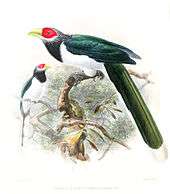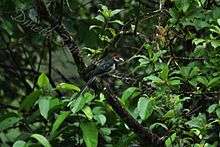Red-faced malkoha
| Red-faced malkoha | |
|---|---|
 | |
| Scientific classification | |
| Kingdom: | Animalia |
| Phylum: | Chordata |
| Class: | Aves |
| Order: | Cuculiformes |
| Family: | Cuculidae |
| Genus: | Phaenicophaeus |
| Species: | P. pyrrhocephalus |
| Binomial name | |
| Phaenicophaeus pyrrhocephalus (Pennant, 1769) | |
 | |
The red-faced malkoha (Phaenicophaeus pyrrhocephalus) is a member of the cuckoo order of birds, the Cuculiformes. This malkoha species is endemic to Sri Lanka
Description

This is a large species at 46 cm with a long graduated tail. Its back is dark green, and the uppertail is green edged with white. The belly and undertail are white, the latter being barred black. The crown and throat are black, and the lower face white. There is a large red patch around the eye and the bill is green. Sexes are similar, but juveniles are much duller.
The red-faced malkoha takes a variety of insects including caterpillars, giant stick insects, mantises and small vertebrates such as lizard. It occasionally may eat berries but this needs confirmation.[2]
Unlike most cuckoos, this is a quiet species, making only the odd soft grunt.[2]
Distribution
It is endemic to Sri Lanka although some old records have apparently erroneously referred to its presence in southern India.[3] According to Baker (1934),[4] it is found in the 'South of Travancore, where it was obtained by Stewart together with its nests'. Later, Biddulph[5] reported a red-faced malkoha in Madurai district, southern Tamil Nadu. Thilo Hoffmann later[6] pointed out that this record would not stand up to a modern records committee, and it is now best disregarded.[7]
The presence of red-faced malkoha in the island is largely confined to the Sinharaja Forest Reserve and the surrounding vegetation, which is one of the biodiversity hotspots in the world.

Habitat
The red-faced malkoha is a bird of dense forests, where it can be difficult to see despite its size and colour.
Breeding biology
It nests in a tree, the typical clutch being 2-3 eggs.
Behaviour
They are found in nearly half of the mixed-species foraging flocks in the Sinharaja area.[8]
In culture
The common name for this species malkoha is the vernacular name for the bird in Sinhala language.[9] 'Mal-Koha' translates to 'flower-cuckoo'. The red-faced malkoha appears in a 5 rupee Sri Lankan postal stamp.[10]
References
- ↑ BirdLife International (2012). "Phaenicophaeus pyrrhocephalus". IUCN Red List of Threatened Species. Version 2013.2. International Union for Conservation of Nature. Retrieved 26 November 2013.
- 1 2 Salgado, Amila (2006) Some observations on the diet of Red-faced Malkoha Phaenicophaeus pyrrhocephalus in Sri Lanka. Forktail 22:122-123 PDF
- ↑ Hoffmann, T. W. (1997) Red-faced Malkohas. Newsletter for Birdwatchers 37(1): 14-15.
- ↑ Baker, E.C.S. 1934. Nidification of birds of the Indian Empire. Vol III, Taylor & Francis, London.
- ↑ Biddulph, C.H. (1956). "Occurrence of the Red-faced Malkoha, Phoenicophaus pyrrhocephalus (Pennant) in Madura district, Madras presidency.". Journal of the Bombay Natural History Society. 53: 697–698.
- ↑ Hoffmann, T.W. (1996). "New bird records in Sri Lanka and some connected matters.". Journal of the Bombay Natural History Society. 93: 382–388.
- ↑ Erritzoe, J.; Fuller, R.A. (1997). "Little-known Oriental bird: Red-faced Malkoha.". Bulletin of the Oriental Bird Club. 26: 35–39.
- ↑ Kotagama, S. W. and Goodale, E. (2004) The composition and spatial organization of mixed species flocks in a Sri Lankan rainforest. Forktail 20: 63–70. PDF
- ↑ Anonymous (1998). "Vernacular Names of the Birds of the Indian Subcontinent" (PDF). Buceros. 3 (1): 53–109. Archived from the original (PDF) on 1 April 2010.
- ↑ http://www.birdtheme.org/country/srilanka.html
